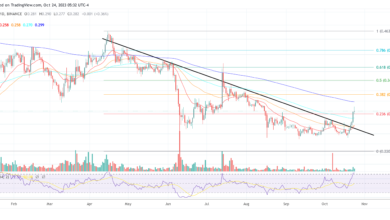Ethereum’s volatility drops to lowest level in 10 years

- ETH’s price volatility has dropped to its lowest point in a decade.
- Its correlation with BTC might keep its price stagnated for a while.
In its 10-year history, Ethereum’s [ETH] volatility has dropped to its lowest level, data from IntoTheBlock revealed. At the time of writing, this was 16%.
Ethereum’s volatility is at a record low.
Throughout ETH’s history, a general trend of decreasing volatility can be observed as the asset gains adoption. Nonetheless, the levels currently being experienced are quite extraordinary.Also note that volatility generally sees… pic.twitter.com/8gl5zKnKUT
— IntoTheBlock (@intotheblock) August 11, 2023
Read Ethereum’s [ETH] price prediction 2023-24
Like Bitcoin [BTC], ETH is infamous for the significant volatility in its price. There has, however, been a noticeable compression in price volatility since November 2022. A closer look at price swings revealed that ETH has since traded within the $1100 and $2000 price ranges.
An asset may witness volatility compression due to becoming more established and accepted by the mainstream. This can reduce volatility as investors become more confident in the asset’s future.
When a crypto asset experiences a volatility decline, its price is less likely to fluctuate wildly. It shores up investors’ confidence, meaning the risk of losing money on ETH’s investments minimizes.
ETH might have gained more popularity amongst investors due to increased activity on Layer 2 (L2) scaling solutions last year. Layer 2 adoption growth and slight monetary tightening have helped ETH beat severe price volatility in the past 12 months.
Where to now?
According to IntoTheBlock,
“Volatility generally sees spikes both upward and downward, with periods of low volatility typically not lasting for longer than one month.”
An assessment of ETH’s on-chain activity suggests that the altcoin might be poised for an upward rally.
Despite the narrow price movement in the past few months, ETH’s exchange activity revealed fewer sell-offs. This means that the coin’s investors had largely refused to sell their holdings and held on to them instead. Per data from IntoTheBlock, ETH’s net flow has been predominantly negative in the last 90 days.
The net flows indicator tracks how traders are sending their coins in and out of cryptocurrency exchanges. When an asset’s net flows are positive, it means more assets are being sent to exchanges for onward sales. Conversely, negative net flows suggest an uptick in accumulation.
At press time, ETH’s net flows stood at -39,980 ETH.

Source: IntoTheBlock
The reduced sell-offs have taken place despite ETH transactions being significantly profitable in the past three months. According to Santiment, ETH’s ratio of daily transaction volume in profit to loss assessed on a 200-day moving average revealed that, for every one transaction that returned losses during that period, 1.27 transactions ended in profit.

Source: Santiment
Is your portfolio green? Check out the ETH Profit Calculator
Although the fall in volatility coupled with ETH’s increased accumulation are positive signals, ETH’s statistically significant positive correlation with BTC might have its price in a fix. Since April, the king coin has traded within the $29,000 and $32,000 price ranges, facing significant resistance at $30,000.
Market sentiment also has to improve. Per Santiment, ETH’s weighted sentiment has been primarily negative in the past 90 days.

Source: Santiment





